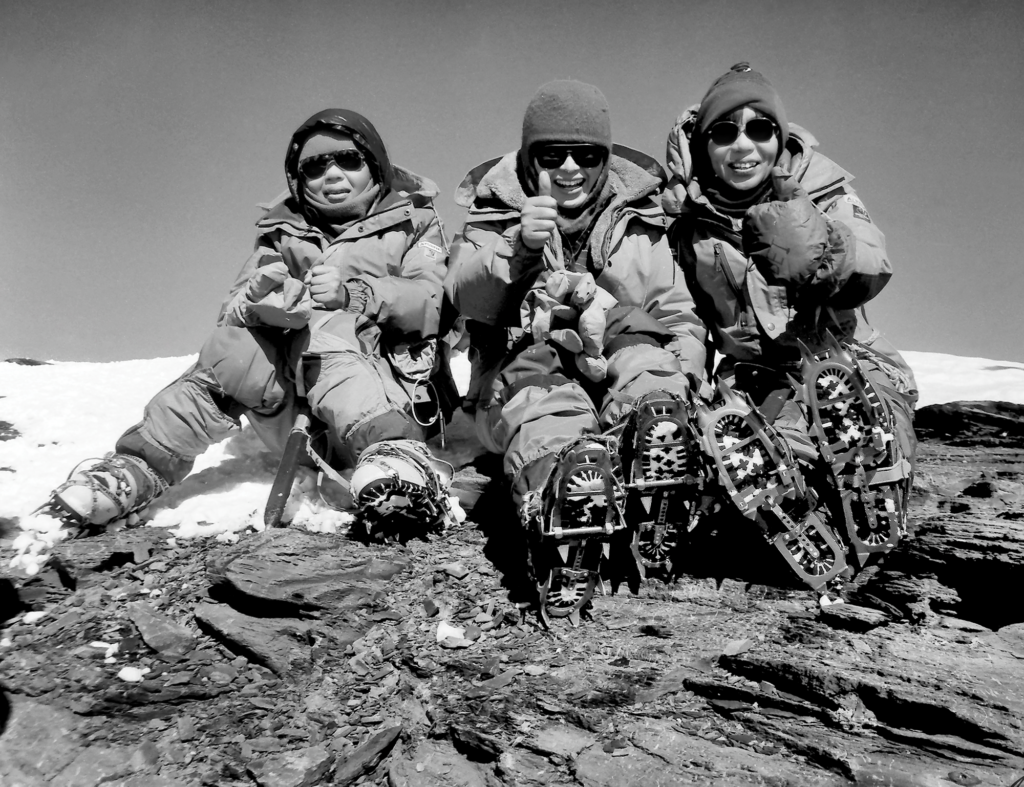If you have interest in mountaineering, Junko Tabei is a woman you’ll eventually come across. This Japanese woman holds the title of being the first woman to reach the summit of Mount Everest, but her story started long before this singular achievement. Tabei lived a life that broke conventions about what was possible for women in the world of extreme sports and mountaineering. She was so impressive that her achievements would still be notable if someone from today accomplished them.
Early life and first steps into climbing
Born on September 22, 1939 in Miharu, Fukushima, Junko Ishibashi (her maiden name) grew up in war torn Japan still rebuilding after World War II. From an early age, she was captivated by the mountains that surrounded her. According to accounts from some friends and family, her passion for climbing began during a school trip to Mount Nasu when she was 10. Her family wasn’t wealthy and climbing wasn’t exactly a common activity for women at the time nor was it known to be a profitable career.
Because of that, young Junko had no way to pursue her dreams. Being one of 7 children in a working class family meant money was tight and post-war Japan was a harsh time.
Japan was very poor at that time, I couldn’t think about climbing mountains or any kind of leisure. We had to worry about what we would eat.
– Junko Tabei in a later interview with Sports Illustrated
She went on to take the safe path and study English literature at Showa Women’s University in Tokyo with aspirations of being a teacher since it was a stable and respectable career path. But try as it may, the harshness of life never killed her passion.
Her chance finally came after graduation when she joined a mountain climbing club. However, even in this setting, she often found herself to be the only woman or one of a handful. Most of her male climbing peers initially saw her as someone who needed to be taken care of rather than as an equal partner such as was common at the time.
Not letting that deter her, she pushed on and within a few years, she’d scaled every major mountain in Japan.1
In 1965, she met Masanobu Tabei who would later become her husband with whom she’d have 2 children. Their shared passion for climbing brought them together and led them to scale numerous peaks together.
In 1969, Junko married Masanobu. The marriage took a long time because Junko’s mother disapproved that Masanobu wasn’t a college graduate.
Founding the Ladies Climbing Club

Recognizing the need for a supportive community for female climbers, Junko, now Junko Tabei, founded the Ladies Climbing Club (Joshi-Tohan Club) in 1969. That’s the same year she got married. The goal of this club was to get female climbers together and organize overseas climbing expeditions. This was a lofty goal at a time when women were barely acknowledged in the mountaineering circles, salaries were low and Japanese people only had about 2 weeks of vacation a year.
Junko herself funded her expeditions from her salary as an editor for the journal of the Physical Society of Japan. With enough money to climb and a group of fellow climbers, the Climbing Club set out to scale mountains abroad.
All in all, the Ladies Climbing Club would organize 44 climbing expeditions around the world with Junko’s presence.
The road to Everest
16 May 1975. Japanese mountain climber Junko Tabei (then aged 35), became the 1st woman to reach the 8,763 metre summit of Mount Everest, the highest mountain on Earth. Tabei’s ascent of Everest was assisted by the use of supplementary oxygen. pic.twitter.com/guSbK4KtxN
— Prof. Frank McDonough (@FXMC1957) May 16, 2024
The Climbing Club applied for permission to climb Everest in 1971 but the climbing schedule had been booked all the way to 1975. Tabei decided to spend the time lining up sponsors in the meantime.
In 1975, Tabei’s team received sponsorships from the Yomiuri Shimbun newspaper and Nippon Television to organize an all-female expedition to Mount Everest. Despite that, each member still had to put up 1.5 million yen ($5,000 at the time) which Tabei paid through piano lessons.
The journey itself was fraught with challenges that tested every climber’s resolve. Just days before her historic ascent, an avalanche struck their camp at 20,730 feet (6,320 meters). Tabei was buried under the snow and debris but was fortunately rescued by the sherpa guides. She was injured so badly that they were forced to spend 2 days recovering but she kept on going.
On May 16, 1975, Junko Tabei reached the summit of Mount Everest. She stood at 29,032 feet (8,849 meters), becoming the first woman ever to scale the world’s highest peak. Her achievement garnered international attention and inspired countless individuals worldwide. She even got a congratulations letter from the king of Nepal.
Yet Junko herself would be humble about it and claim that she was the 36th person to climb Everest rather than the 1st woman. Part of it might have been in deference to her colleagues as there were originally supposed to be 2 women that were planned to reach the peak though the sherpa guides couldn’t carry enough oxygen bottles for 2 climbers at the time.
Beyond Everest: Life doesn’t end there
While conquering Everest is her most notable achievement, this was just one check out of a very long list of her accomplishments as a climber both before and after that historical feat. Junko wasn’t one to rest on her laurels.
She had her sights set on another monumental challenge: the Seven Summits.2 This term refers to reaching the highest peak on each of the seven continents.
Over several years, she successfully climbed:
- Mount Kilimanjaro in Tanzania (19,341 feet / 5,895 meters) in 1980
- Aconcagua in Argentina (22,837 feet / 6,961 meters) in 1987
- Denali (formerly known as Mount McKinley) in the USA (20,310 feet / 6,190 meters) in 1988
- Mount Elbrus in Europe (18,510 feet / 5,642 meters) in 1989
- Vinson Massif in Antarctica (16,050 feet / 4,892 meters) in 1991
- Mount Kosciuszko in Australia (7,310 feet / 2,228 meters) in 1992
In completing these climbs by 1992, Junko Tabei became not only the first woman to reach Everest’s summit but also the first to conquer the Seven Summits (which includes Everest).
Environmental advocacy and legacy
A lesser known aspect about Junko was that beyond being a mountaineer, she was also an environmentalist. She was concerned about the degradation and littering she witnessed in some of the world’s most pristine landscapes. This concern extended even after her climbing days were over. She pursued environmental education at Kyushu University and contributed to projects aimed at cleaning up mountains.
She would continue on to participate in cleanup climbs in Japan and the Himalayas and was the director of the Himalaya Adventure Trust of Japan.
In 2012, Junko was diagnosed with stomach cancer but continued to lead climbs and youth expeditions.
Junko passed away from her cancer on October 20, 2016 in Kawagoe. Yet her legacy lives on through various initiatives and the inspiration she gave climbers around the world.
Remembering her legacy
Too often, we put a huge amount of importance on accomplishing big things in our 20s because everything should be figured out by our 30s. But life never goes our way does it? Junko Tabei’s story isn’t just one of a woman breaking gender barriers or reaching the top of Everest. It’s one of grit and determination over a lifetime.
She didn’t shatter Japanese society’s expectations in a single climb, nor did she break the mold when she reached the peak of Everest. Her accomplishments lie in her entire lifetime of working towards her goals step by step. Knowing it would lead to something more if she kept inching closer to her goal.
Junko may have only been 4ft 9 (145 cm), but her legacy is larger than life because of her lifetime’s worth of unrelenting work.
So here’s to Junko Tabei, climber of mountains and barriers alike. May her story continue to inspire firsts for generations to come.
FAQ
How did Junko Tabei die?
Junko died of stomach cancer in October 20th, 2016. That’s 4 years after her initial diagnosis in 2012.
When did Junko Tabei climb mount Everest?
Junko climbed to the top of Everest on May 16th, 1975 making her the 1st woman and 36th person to reach the top of mount Everest.
How old was Junko Tabei when she climbed mount Everest?
Junko was 36 at the time of her record breaking climb.
How many times did Junko Tabei climb Mount Everest?
Junko climbed Everest twice. Once in 1992 and once in 1996 making her the first woman to reach the summit along with being the first woman to climb from both the north and south sides.
How tall was Junko Tabei?
Junko was 4ft 9 (145 cm)3 tall.
- https://vault.si.com/vault/1996/04/29/no-mountain-too-high-for-her-junko-tabei-defied-japanese-views-of-women-to-become-an-expert-climber ↩︎
- The Seven Summits are a disputed group of 9 mountains, 7 of which constitute the ultimate climb as it represents all 7 continents. ↩︎
- https://www.dimensions.com/element/junko-tabei ↩︎








